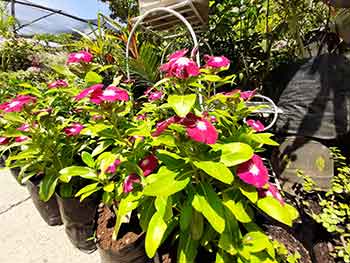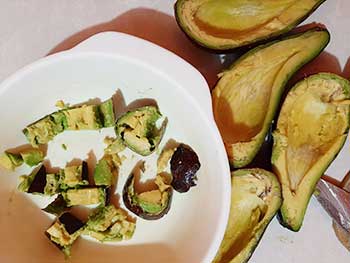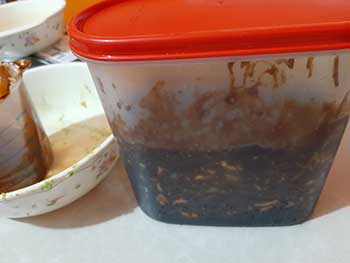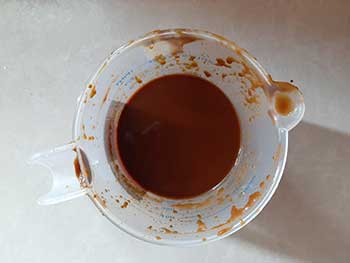There are plenty of articles detailing the benefits of using Fermented Fruit Juice as an organic fertilizer for your garden. If you don’t know it yet, fermented fruit juice is a fertilizer made by soaking fruits and fruit peel in a sugar mixture for a week or maybe even a month. It is widely used in the flowering and fruiting stages of a plant. So if you want to have more flowers or more fruits in your garden, then using fermented fruit juice or FFJ would be a great idea. In my garden, I use it to fertilize my tomato and pepper plants. I also apply the fermented fruit juice to my ornamental plants and they are now blooming wonderfully.

In making the fermented fruit juice, you can use almost any type of fruit. In this article, I will be showing you how I made one, using avocado since I have lots of avocados at home and some of them are overripe already. This is one of the reasons why making a fermented avocado fertilizer should be made by every urban gardener. Avocados tend to get ripe very fast. One day, they are totally fine, and the next day, they are too ripe to eat. To minimize the waste, why not make it into an effective organic fertilizer.
Aside from converting into fertilizer instead of throwing it in the garbage, avocados also contain good amounts of nutrients that plants can use. Based on the United States Department of Agriculture (USDA), 201 g avocado contains 973 mg of potassium and 23 mg of calcium. Potassium is a basic macronutrient needed by plants, along with nitrogen and phosphorus. By fermenting avocados, you can extract these nutrients which can then be used as organic fertilizer.
Recommended Fruits for Fermentation
Aside from avocados, you can use other fruits to make fermented fruit juice. Here is a table of fruits with their corresponding nutrients:
Fruit | Serving Size (grams) | Potassium (mg) | Calcium (mg) |
Avocado | 201 g (medium-sized) | 973 | 23 |
Banana | 118 g (medium-sized) | 517 | 78 |
Zucchini | 196 g (medium-sized) | 512 | 31 |
Cucumber | 301 g (medium-sized) | 442 | 48 |
Squash | 116 g (1 cup) | 404 | 33 |
Mango | 165 g (1 cup) | 277 | 18 |
Apple | 182 g (medium-sized) | 193 | 10 |
Carrot | 61 g (medium-sized) | 193 | 20 |
Watermelon | 152 g (1 cup) | 169 | 10 |
Lemon | 58 g (medium-sized) | 80 | 23 |
I got this data from the United States Department of Agriculture (www.usda.gov).
So, instead of throwing leftover fruits, it is better to convert them into organic fertilizer. According to a survey conducted by the Produce Marketing Association, avocados ranked 8th among the top 20 fruits bought in the US. Bananas ranked first, with apple ranking 2nd. These 3 kinds of fruits make for a good fermented fruit juice.
Making the Fermented Avocado Fruit Juice
Step 1. Remove the avocado seed. Chop the avocado including avocado peel into small slices.
Avocado is a bit soft, and chopping it into small pieces may be difficult. It is more difficult if the avocados are overripe. However, don’t worry about this, it is not necessary to cut it into an exact size. If you find this slightly annoying, you can simply use a spoon and scoop out the avocado. This is what I did after deciding that the avocados I’m using are just too ripe to be sliced cleanly.
For the avocado peel, you can slice this into tiny half-inch strips and add to the mixture. Being soft also presents an advantage because the beneficial microorganisms can easily break it down.

Step 2. Place the avocado slices inside a clean container.
You may use a plastic or glass container. Never use containers made out of metal. I used a plastic one but it has a narrow shape. I would have preferred a circular one, but this was what I had in my kitchen at that time. The metals will interact with the mixture and you will not get the desired fermentation results. Also, make sure that it has a lid.

If there is no lid, just use a page from a newspaper or magazine to cover it and secure it with a rubber band or string. It is important to seal the mixture, later on, to prevent contamination from insects, bugs, or bad bacteria. If insects find their way into the mixture, they could lay their eggs there. These eggs will eventually become maggots and they might foul the fermentation process. Luckily, in all of my fermented fruit preparations, I never had experienced having maggots in the mixture.
Step 3. Add the molasses.
The molasses will serve as the food source for the beneficial or indigenous microorganisms (IMO). Mix using a clean ladle or spoon. If you don’t have access to molasses, you may substitute it with brown sugar. I still had some extra molasses left from the fermented plant juice I made last month, so that was what I used. Preparing the fermented plant juice is similar to fermented fruit juice, the difference being that the plant juice is used during the vegetative phase of plants. For more information about Fermented Plant Juice, I wrote a separate article on it and you may open it here.
The IMO is what jumpstarts the fermentation process. These microorganisms live on the surface of organic matter and are responsible for breaking it down. By breaking down the organic matter, the nutrients are released into the sugary mixture. Since they are present on the surface, it is important not to rinse the avocado in water so as not to wash away the microorganisms. The ratio of molasses to fruit is 1:1. For example for every 200 grams of fruit matter, use 200 grams of molasses.

Step 4. Cover the container and let it sit for a week.
Be sure to place the container in a cool and dry area. Never place it in direct sunlight as molds may form, although brightly-colored molds (white, yellow, orange) are ok. If the molds have a dark color, then the mixture is contaminated. The fermentation process has failed and you have to throw the mixture away. There was one time when I saw white molds on my mixture. At first, I was disappointed but I just mixed it again using a spoon and hoped for the best. The next day, the molds were gone and I was able to harvest the fermented fruit juice in 2 weeks.
The fermentation process could take anywhere from 1 week to one month. This depends on the temperature and humidity of your area. In my case, I like to let it sit for three weeks just to be sure. To check if the fermentation process is indeed taking place, you can open the container and smell the mixture. You should smell a faint scent of alcohol. If your container is transparent, you should observe the liquid settling down at the bottom.
During the fermentation process, gases will be produced. It is important to open the lid once in a while to let the gases out.
Step 5. To harvest, separate the liquid from the remaining solids.
When it’s time to harvest, use a strainer to extract the liquid. You will only need the liquid part of the mixture. You can squeeze out the remaining solids to extract more fertilizer fruit juice. The liquid is what is known as Fermented Fruit Juice or FPJ (Fermented Avocado Fruit Juice, to be exact). It should still have that alcohol scent. You can place the liquid on a clean plastic or glass container.
When kept in a cool and dry area, the fermented avocado fruit juice fertilizer can be used for a year. The juice contains nutrients that are beneficial to plants. As this was made with avocado, the potassium and calcium content is very high.


How to Use the Fermented Fruit Juice
To apply the fermented avocado fruit juice, dilute it first in water. The ratio is 10 ml per liter of water or roughly 1 tablespoon per liter of water. Shake properly before using it. You can use this as a soil drench or as a foliar spray. Foliar spray involves directly spraying the fermented fruit juice fertilizer to a plant’s leaves. For me, I prefer the spray method. Be sure to spray in the late afternoon to avoid direct sunlight. Do this once a week.
In the procedure I described above, I was able to produce around 200 ml of fermented avocado fruit juice. For every application in my garden, I consume a liter of FPJ. This means I only use 10 ml per application. At this rate, my 200 ml can be used for 20 weeks or about 5 months. Just by saving the overripe avocados from the trash bin (3 to be exact), I can fertilize my plants for almost half a year. This sounds like a good idea to me.










